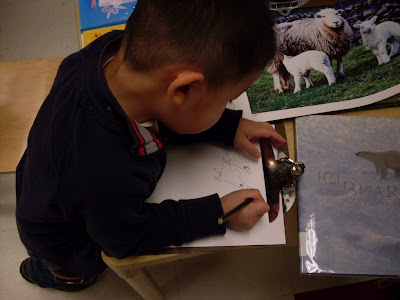This week we began by coming up with ideas for how we could find the answers to our questions. The children came up with excellent options, saying "we can go outside and check," "go to the Queens Zoo," and "use the computer." I added books to the list. This week we have been using books and the computer each day in the research center to learn more about animals that hibernate. I have found some excellent video footage on the National Geographic Kids Website and Animal Planet, here are the links so you can watch at home with your child - use this as a great chance to discuss what they already know!
http://kids.nationalgeographic.com/kids/animals/creaturefeature/polar-bear/
http://animal.discovery.com/videos/natural-world-bear-hibernation.html
Also, Brain Pop Jr. offers a free one week trial and has some wonderful videos and activities to explain hibernation, migration, and much more. I would definitely recommend giving it a try and watching it with your child. Here is the address,
http://www.brainpopjr.com/
We are using nonfiction and fiction books to learn more about where animals live and how they survive in the winter. Sometimes we use paper and pencil to sketch the animals we see.


We are created a large mural to represent what we are learning. We began by looking through our big picture book of animals, noticing that some animals live where there is a lot of ice and others like where grass and trees dominate. We spoke about these different habitats as the Arctic and the forest. Children used the photographic picture book to paint half of the mural as the Arctic and half as a forest.


The next day we spent time thinking about the animals that live in a forest and that hibernate. K and H made bears, A made a bat, S made a turtle, and A made a frog. Their mixed media collage animals will be added the mural. Next we'll create Arctic animals, and add animals that migrate. The mural will grow over the weeks of our investigation and function as a representation of our learning. In the end, I'm thinking we can write a shared story or explanation of the mural.

There has been interest in storytelling in the dramatic play center, it started with the introduction of our shadow puppets but puppetry and storytelling are tough and interest began to wane. Mrs. Lee and I focused on reigniting the interest by providing a good deal of support (at least to begin with) and slowly we will provide less support in hopes that the children will take charge of the show. It has been so fun to watch the excitement of children working on using different voices for characters, and telling a story together. This week we have been using The Three Snow Bears by Jan Brett. As we grow more confident as storytellers and actors perhaps we'll write our own story to perform!


No comments:
Post a Comment